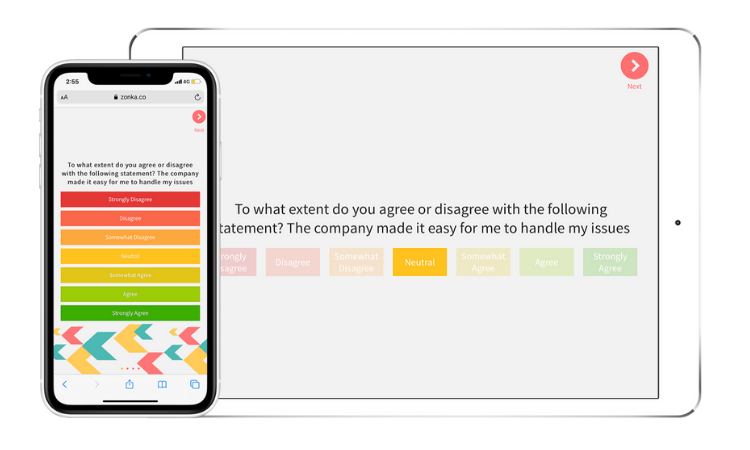What you will do, if you make lots of effort to buy any product, making an online payment or to get your queries resolved? Simply, you will churn out of the website and never recommend that business to your friends or relatives.
Nowadays, customer experience has become a key driver of customer satisfaction and loyalty. Be it online purchase, managing transaction or the response to their queries, customers expect from business to get all these things done with less effort.
Over the past decades, Customer Effort Score (CES) has become the business-critical Customer Feedback Metrics, when the Harvard Business Review published an article titled 'Stop Trying to Delight Your Customers'. In this article, they emphasized that reducing efforts is much more important than delighting your customers.
What is the Customer Effort Score (CES)?
Customer Effort Score (CES) is the leading customer feedback metric that helps you to gauge the level of effort a customer has to exert to get an issue resolved. The customer effort score can be calculated with the the right CESQuestion that "To what extent do you agree with the following statement: The company made it easy for me to handle my issue." Customers usually provided with the scale ranges from 1-7 to rate their effort experience:
1 = Strongly Disagree
2 = Disagree
3 = Somewhat Disagree
4 = Undecided
5 = Somewhat Agree
6 = Agree
7 = Strongly Agree
This is also known as CES 2.0. Here in this scale range, a 1-3 segment (Strongly Disagree to Somewhat Disagree) will be associated with negative results, whereas the 5-7 segment (Somewhat Agree to Strongly Agree) represents positive results.

Why to Measure Customer Effort Score?
Customer Effort Score as a metric or a benchmark that cannot only improve the experience of your customers but also helps you to develop long-lasting customer-relationship. It is being considered that if a business delivers an effortless experience to its customers, then only they can remain connected with your brand.
In fact, Harvard Business Review stated that 94% of businesses would buy your product again if they cite a low level of effort from working with you. So, every business needs to focus on improving their customer effort score.
How to Improve Customer Effort Score (CES) at Your Company?
High customer effort scores can easily take your customers away from your business and bring down your business growth. When it comes to improving or reduce the customer effort score, various factors like accurate resources, strategies, tools, and manpower are playing a crucial role.
So, explore 5 easy ways to lower your customer effort score and deliver effortless experiences:
1. Make Yourself Easily Accessible at Every Touchpoint of the Customer Journey
Today's customers are tech-savvy, besides premium-quality products and services, they expect brands to treat them with seamless experiences. They don't want to do many efforts or move from one channel of communication to another to achieve their goals. So, keeping this in mind, businesses have to make themselves easily accessible to their customers at every possible touchpoint.
Businesses should provide easy-to-access feedback channel where customers can speak about the company's products/services and share their grievances for any inconvenience. So, to make sure that you are easily accessible to your customers, you should start gauging and monitoring the entire customer at various touchpoints.
Make yourself connected to customers easily by deploying multi-channel feedback options including Email Survey, SMS Survey, Kiosk, QR Codes, Tablet Feedback system, and many more.
According to Zingle, customers have experienced a 400% increase in response rate with text message surveys compared to the industry average email survey response rate.
For example, Amazon actively engaged with its customers and communicate them at various touchpoints including post-order confirmation, post-payment, and post-delivery. They make themselves available at every channel including chat, call, and email.
2. Improve the Level of Self-Services You are Offering
When it comes to providing self-service experience to the customers, businesses use various resources including a full-fledged knowledge base. But setting up a good knowledge base is not enough. You need to update and enhance your knowledge base regularly. Besides all these, you need to take care of the placement of your knowledge base.
For example, say if you are a survey service provider and customers visit at your Net Promoter Score page. So, to reduce their efforts experience, you can either put the NPS knowledge base at the bottom of the page or you can also put some FAQs related to it. This helps your customers or visitors to understand your business and services without investing more effort.
3. Reduce Your Average Response Time
Response time is also another important factor that constitutes the overall experience of the customers. if you want to low down the Customer Effort Score, then you need to focus on improving your approach to responding to your customers.
Average response time is pegged at 7.3 hours and the standard resolution time is 24.8 hours. (Freshdesk's)
When your customers raised any query, always respond to them quickly. Your customer support team should keep itself active over every communication channel like a chatbox, messenger, complain site. This helps them to quickly address the issues of customers. When customers get their queries solved quickly without investing much effort, they will build a positive perception of the brand.
4. Close the Negative Feedback Loop
Getting negative reviews from customers is not the biggest concern, as long as figure out the solutions to mitigate their impact. When you received negative feedback from your customers, don’t panic. Strategize to mitigate the impact of negative feedback and focus on closing the feedback loop on a positive note to improve the customer experience.
So, if you want to retain your customers then start following up with your customers who responded with a negative rate and closes the negative feedback loop. When you follow up with your grumpy customers and address their grievances, this gives a positive impact on customers that you are really concerned about their negative experience and want to improve it. Closing a negative feedback loop provides you with the opportunity to reduce the customer churn rate and rebuild customer loyalty.
5. Evaluate Your Customer Service Performance
Customer Service is the linchpin that determines the success of the business. Today’s customers are tech-savvy and expect everything to be quick and seamless. Thus, slow response time and high effort experience can turn your customers away from your website. So, if you want to improve the customer experience, you need to speed up the communication process to reduce the interaction efforts.
Customer Effort Score metric will not only evaluate the customer efforts to interact with you but also help you to find specific points where you can speed up communication.
 Integrations
Integrations







-min-1.png)
.jpg)
.jpg)
-1.png)
.jpg)

















